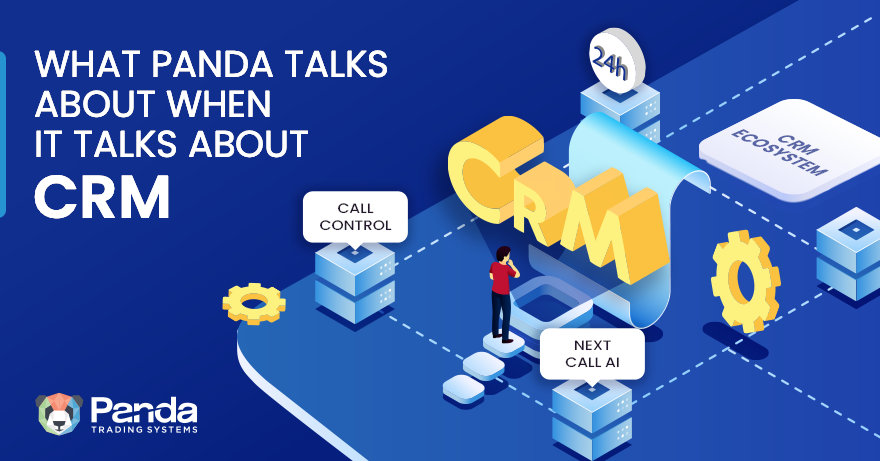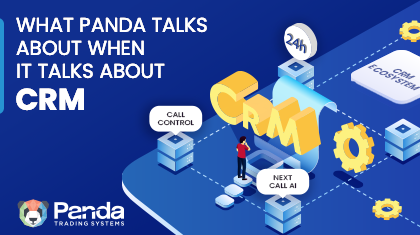
Panda Announces Historic Integration with cTrader Platform
August 4, 2022
Should Brokers Replace Humans with Technology?
September 14, 2022
CRM. Customer Relationship Management. If you’re reading this article, chances are you already have a pretty good idea of what a CRM is and what it’s for. Those three words may also have just conjured up a bunch of associations for you, and those associations are probably going to differ depending on how long you’ve been in the workforce, and in which industry you encountered your first CRM.
For some of you, the first CRMs you encountered were basically just glorified spreadsheets. For others, they were more like software phonebooks, combining contacts, calendar, and email functionality. But the term is so broad and has been around for so long, that it’s essentially becoming meaningless. This is because it covers such an array of different use cases and functionalities going all the way back to the 1990s.
The point of the following article is to bring you up to speed regarding the developments that inform today’s modern brokerage CRMs, which is the segment we specialise in. The idea is to bring decision-makers up to speed with what’s new in this field. So, if you’ve recently had to turn your attention to this key piece of your brokerage infrastructure, you could do a lot worse than starting your CRM research here.
1.0 Vs 2.0
The earliest CRMs were indeed glorified spreadsheets that evolved to integrate customer contacts and email functionality, harnessing whatever new technologies were becoming widespread across the Web at the time. All in an effort to stay as up to date with client relationships, at scale, as the technology would allow. The Internet is actually a good analogy here. Imagine what the word “website” meant to someone who lived in a Web 1.0 world, as opposed to someone who only knows Web 2.0.
Or better yet, what did the word “mobile” mean to someone in the pre-smartphone era versus someone with an iPhone 13 in their hands? When it comes to most people’s understanding of CRM, they still live in a Web 1.0 world, where mobiles have green screens and backlit buttons. And you can’t really blame them, the only folks really keeping up to date with CRM technology are those constantly developing these systems.
The reason it’s important to start by questioning the term itself, is that if you’re a decision-maker currently tasked with overhauling your current CRM, you may be operating under some out-of-date assumptions about what the available technology can actually do for your business today. Knowing how far these systems have come, in just the past few years, is important if you’re to re-think how your business can use these developments to optimise efficiency at every level.
“When it comes to most people’s understanding of CRM, they still live in a Web 1.0 world, where mobiles have green screens and backlit buttons.”
Then and Now
As already discussed, if you’re coming to CRM from yesterday’s point of view, you’re probably imagining some kind of independent software suite in which client contacts and account notes are consolidated, with some sort of native email functionality and calendar information for use primarily by sales, retention and CS.
This is the most fundamental point of departure between yesterday’s CRMs and today’s bleeding edge systems. Today CRMs aren’t just add-ons, they’re the central hubs through which all client interactions are catalogued and made available (on a permissioned basis) to relevant members of staff.
More than that, they’re also the central communication point between staff and clients, but also internally between departments. Moreover, they should be able to consolidate all client activity across all client-facing touchpoints, including company websites, client area, trading platforms, and even marketing campaigns such as landing pages, making these data available to members of staff who are currently logged in and on duty. In this way, relatively small teams can be much more efficient in their client communications, prioritising each and every outgoing communication in a far more surgical manner.
Finally, with orders of magnitude more data coming in than in the case of traditional CRMs, there now have to be intelligent systems in place to make sense of this abundance of data, turning it into actionable insights for all relevant teams.
So, to recap, when we at Panda say CRM, we’re talking about a collection of systems that form the central nervous system of a modern brokerage, allowing for storage and retrieval of information, internal and external communication, bird’s eye views of client activity across all company real estate, and finally, some sort of AI component to make sense of all the incoming data.
“Once you have an appropriate means of listening to and capturing incoming brokerage data, there’s a lot of innovation that can take place, allowing smaller teams to compete with bigger ones”
3 Non-Negotiables
All this is to say, for a CRM to be worthy of its name in today’s day and age, it should tick the following three boxes.
- It should be the central, shared environment through which all departments are able to communicate, both internally and externally, in a variety of media, including email, chat, VoIP, video call and voice note.
- Having all of these materials and features available to the entire organisation requires certain permissions to be in place. So a system worth its salt should allow you to map your entire business’s hierarchy and easily update this formal map as team members come and go, or rise through the ranks. This involves the ability to assign the appropriate privileges to different levels of staff, as well as ensuring that all data is otherwise encrypted for any party without the correct access credentials. This protects your business from data leaks originating both outside and from within your organisation.
- Finally, the system should be customisable, so that you’re not trying to fit your business into the CRM’s box, but rather, the system can be tailored to enhance your existing organisational structure. Cosmetically this means it should be fully branded, but under the hood, this means it actually makes life easier for your various departments, rather than ending up in a situation where, as is often the case, they end up having to work around it in order to maintain productivity.
Panda’s CRM Journey
As an established technology provider in the space that specialises in custom solutions, we had already gained a great deal of in-house, hands-on expertise with all the various components of a modern brokerage, including trading platforms, client areas, marketing portals, affiliate systems, call center technology, and more.
So, when it came to the development of our own flagship CRM system, it was built from the ground up to integrate with all of our other brokerage software, so that information can be shared between departments and issues resolved more fluidly. The biggest gripe we would hear from clients before developing our own CRM, was how annoying it was to get existing CRMs to listen and talk to other brokerage systems. A lot of our early work in this space was actually in providing software work-arounds for the limitations of existing systems.
We wanted Panda CRM to be connected to everything and to be a central hub from which all relevant teams can draw information and communicate through. From a C-suite perspective, we wanted it to be simple and intuitive for upper management to create hierarchy trees of their businesses, providing all the relevant access and monitoring privileges to key staff. This includes offices located in far-flung geographies, so, no-matter the size of the brokerage in question or the distance between teams, they can coordinate just as efficiently and continue to add an unlimited number of user profiles as the business grows.
In practice, these hierarchy trees make it easier for managers to perform their duties well. This is because they’re afforded a real-time view of each team member’s activities and performance (in the same way that the individual team members are afforded real-time views of client activity). The intelligence of the system is in the way it harnesses data to introduce efficiencies at every level, with individuals at the very top of the hierarchy able to see the broader business strategy being implemented in real time at every level of the business.
The AI Connection
AI is the element that brings all of the above together and makes it possible at scale. It was clear to our engineers very early on, that as you start to consolidate these various data streams a typical brokerage has access to (website activity, funding activity, trading activity, communications with the business etc.) you quickly end up with more data than you can meaningfully process. Certainly, more than your human team members are able to act on.
Our people kept a close eye on developments in open-source AI, and when the time was right, they started incorporating these tools into our CRM as expansion modules.
Two huge leaps in the underlying functionality of Panda CRM were made during this time. The first was an AI document verification module that automates most of the back-and-forth usually associated with getting problematic document uploads to be correctly re-uploaded. The system has proven invaluable for overworked back office and compliance teams, particularly during times of peak traffic, since it not only handles a lot of the repetitive communications they previously had to deal with, but it also allows them to target their own communications by ranking incoming document submissions for them according to different criteria.
The second development was Next Call AI, a module designed to make sense of all the data generated by the system’s ability to track client behaviour at quite a granular level. Next Call uses this data to inform sales/retention teams of the next outgoing call they should prioritise based on what clients are currently trying to achieve. For example, a first-time deposit that’s failing to go through, or a high-net-worth client venturing out onto the trading platform for the first time.
More recently, we introduced Call Control, a module that records customer calls, transcribes them, and assigns sentiment scores, as well as listening out for keywords (preset by management). It’s an invaluable call operator training tool, as well as massively useful market research tool.
The common thread between all of these developments is that once you have an appropriate means of listening to and capturing incoming brokerage data, there’s a lot of innovation that can take place, allowing smaller teams to compete with bigger ones.
In Conclusion
Your business’s CRM isn’t just an add-on and shouldn’t be an afterthought. If you imagine it as such, you’re limiting what it can potentially achieve for you. This is becoming all the more important as the online trading segment gets more competitive, and is where algorithmic advantages will make all the difference. We’re moving to a world where the company with the most intelligent systems and efficient departments will outcompete those with the largest call centres or biggest marketing budgets.
This means systems designed to capture, store and incorporate all incoming brokerage data into a central interactive repository, not disparate legacy systems managed and maintained by overworked human teams. It also means thinking about introducing automation to any areas of business logic that can easily be formalised algorithmically, which lessens the reliance on human teams, and frees them up for more creative and productive work.
Finally, it means customisation. The initial problem only exists because of legacy third-party systems that don’t do a great job of communicating between themselves. The way out is to ensure that the software systems you are using have been implemented with your specific business logic in mind. We are, of course, subtly gesturing towards ourselves here, but whether you end up becoming a Panda client or not, we’d be more than happy to discuss any of the issues raised in this article with you further. Don’t hesitate to get in touch.
For free consultation
Request a Call
